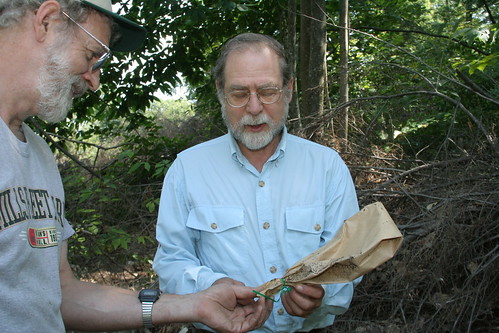
This post is part of the Science Tuesday feature series on the USDA blog. Check back each week as we showcase stories and news from the USDA's rich science and research portfolio
When Jack Lochhead looked into a federal government program to help him manage his 250 acres of forest land in rural Conway, Massachusetts, he had no idea that it would lead to a surprising discovery deep in the forest.
Through the USDA Natural Resources Conservation Service’s Wildlife Habitat Incentive Program, Lochhead sought technical and financial help to manage his land. NRCS staff suggested an oak regeneration project which calls for land around existing oak trees to be thinned to allow new oak seedlings to take hold.
Historically in Massachusetts, oak trees dominated forest ecosystems. But land cleared for farming and timber harvesting during the past few hundred years grew back with different prevalent tree species. The oak regeneration project helps restore natural forest conditions and provide valuable habitat for native wildlife.
Lochhead and NRCS staff decided to place the project site deep in the forest in case it didn’t work out exactly as planned. That decision led to a startling discovery—a lone American chestnut tree.
The American chestnut is a large, deciduous tree that populated eastern forests until it was devastated by the chestnut blight, a fungal disease. Before the first half of the 20th century, chestnuts covered 200 million acres of eastern woodlands from Louisiana to Maine—making up about a quarter of the hardwood trees in these forests and providing habitat for countless creatures. Healthy adult American chestnut trees are rarely found in their native range these days.
Lochhead called Brian Clark, the local representative for The American Chestnut Foundation (TACF), which is working to restore the chestnut to its native range. “He came out right away, took a look and said ‘Yeah, that’s an American chestnut and it’s in good health,’” Lochhead says.
In an interesting twist, the oak regeneration project actually helped the chestnut, too, he says, “Because it’s right on the edge of the cut, it’s getting a lot more light than it got before, so it’s a much more vigorous tree now.”
Lochhead’s tree is now part of TACF’s breeding program. Surviving trees are crossbred with a blight-resistant mixed strain of Chinese chestnut and American chestnut. The nuts are harvested and planted and the seedlings are deliberately infected with the blight. Those that stay healthy will be replanted. Trees like Lochhead’s provide valuable genetic material for the project, as it moves closer to its goal of repopulating eastern forests with the beautiful American chestnut tree.


